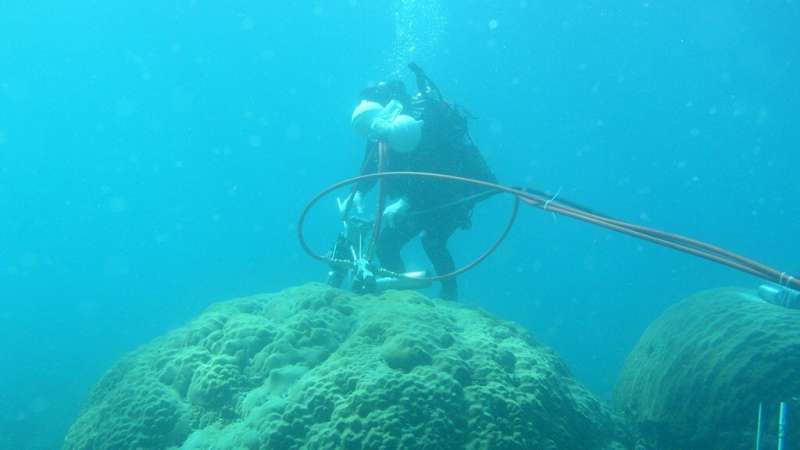Coral chemistry reflects Southeast Asia’s economic expansion
Economic expansion leaves indelible marks on coral chemistry, according to a new study published in the Journal of Geophysical Research: Oceans. By analyzing barium levels in coral cores, scientists can access decades-old records of regional development and erosion rates.
East and Southeast Asia have experienced rapid development over the past six decades. Cities in the region have sprawled, forests have disappeared, and agricultural fields have spread, leading to the fastest soil erosion rates in the world. Experts predict that the rates will continue to increase.
Understanding where and how quickly soil is eroding is important for rapidly developing countries to sustain their agricultural output, but for many parts of East and Southeast Asia, long-term records are lacking.
Corals, it turns out, have been keeping track. When sediments from land make it to the sea, they carry with them elements such as barium. Those elements change the ocean’s chemistry and enter the skeletons of corals and other shallow-sea animals. Because barium is largely sourced from continents, its prevalence in coral skeletons could reflect the erosion of sediments from land to sea.
Xiaohua Li and colleagues present a new multidecadal record of erosion based on barium concentrations and isotopes from coral cores. The cores came from the South China Sea near southern Taiwan and central Vietnam. Each one provided about two decades of data recorded at a monthly resolution.
The core from Taiwan developed between 1980 and 2004. From 1980 to about 1995, both Taiwan’s gross domestic product (GDP) and coral barium content increased, suggesting a link between development and erosion. Starting in 1996, GDP continued to grow, but erosion decreased. That decoupling could reflect effective soil conservation efforts, the authors say.
The Vietnam core, which developed between 1978 and 2003, also showed a correlation between economic development and erosion. From the 1990s to the 2000s, Vietnam’s urban areas grew about tenfold, and the coral’s record of erosion increased as well.
Corals may be an important historical record of erosion and economic expansion, but with threats of climate change, ocean acidification, and sediment input looming large, their dutiful watch may soon come to a close.
More information:
Xiaohua Li et al, Coral Record of Increased Soil Erosion Since East and Southeast Asia Economic Boom, Journal of Geophysical Research: Oceans (2023). DOI: 10.1029/2022JC019397
This story is republished courtesy of Eos, hosted by the American Geophysical Union. Read the original story here.
Citation:
Coral chemistry reflects Southeast Asia’s economic expansion (2023, May 11)
retrieved 11 May 2023
from https://phys.org/news/2023-05-coral-chemistry-southeast-asia-economic.html
This document is subject to copyright. Apart from any fair dealing for the purpose of private study or research, no
part may be reproduced without the written permission. The content is provided for information purposes only.

Economic expansion leaves indelible marks on coral chemistry, according to a new study published in the Journal of Geophysical Research: Oceans. By analyzing barium levels in coral cores, scientists can access decades-old records of regional development and erosion rates.
East and Southeast Asia have experienced rapid development over the past six decades. Cities in the region have sprawled, forests have disappeared, and agricultural fields have spread, leading to the fastest soil erosion rates in the world. Experts predict that the rates will continue to increase.
Understanding where and how quickly soil is eroding is important for rapidly developing countries to sustain their agricultural output, but for many parts of East and Southeast Asia, long-term records are lacking.
Corals, it turns out, have been keeping track. When sediments from land make it to the sea, they carry with them elements such as barium. Those elements change the ocean’s chemistry and enter the skeletons of corals and other shallow-sea animals. Because barium is largely sourced from continents, its prevalence in coral skeletons could reflect the erosion of sediments from land to sea.
Xiaohua Li and colleagues present a new multidecadal record of erosion based on barium concentrations and isotopes from coral cores. The cores came from the South China Sea near southern Taiwan and central Vietnam. Each one provided about two decades of data recorded at a monthly resolution.
The core from Taiwan developed between 1980 and 2004. From 1980 to about 1995, both Taiwan’s gross domestic product (GDP) and coral barium content increased, suggesting a link between development and erosion. Starting in 1996, GDP continued to grow, but erosion decreased. That decoupling could reflect effective soil conservation efforts, the authors say.
The Vietnam core, which developed between 1978 and 2003, also showed a correlation between economic development and erosion. From the 1990s to the 2000s, Vietnam’s urban areas grew about tenfold, and the coral’s record of erosion increased as well.
Corals may be an important historical record of erosion and economic expansion, but with threats of climate change, ocean acidification, and sediment input looming large, their dutiful watch may soon come to a close.
More information:
Xiaohua Li et al, Coral Record of Increased Soil Erosion Since East and Southeast Asia Economic Boom, Journal of Geophysical Research: Oceans (2023). DOI: 10.1029/2022JC019397
This story is republished courtesy of Eos, hosted by the American Geophysical Union. Read the original story here.
Citation:
Coral chemistry reflects Southeast Asia’s economic expansion (2023, May 11)
retrieved 11 May 2023
from https://phys.org/news/2023-05-coral-chemistry-southeast-asia-economic.html
This document is subject to copyright. Apart from any fair dealing for the purpose of private study or research, no
part may be reproduced without the written permission. The content is provided for information purposes only.
